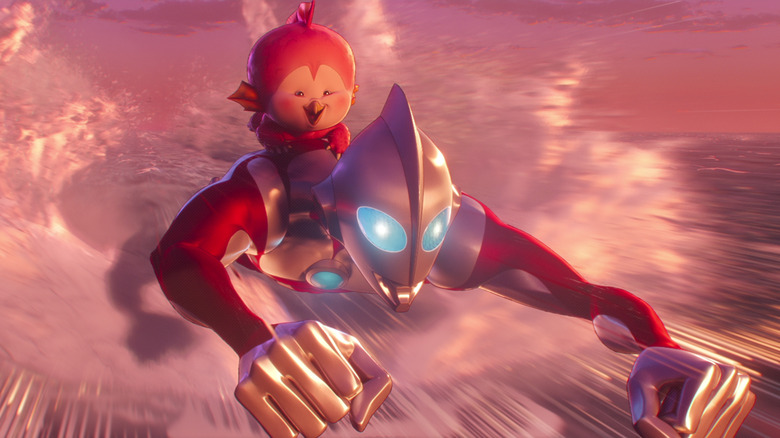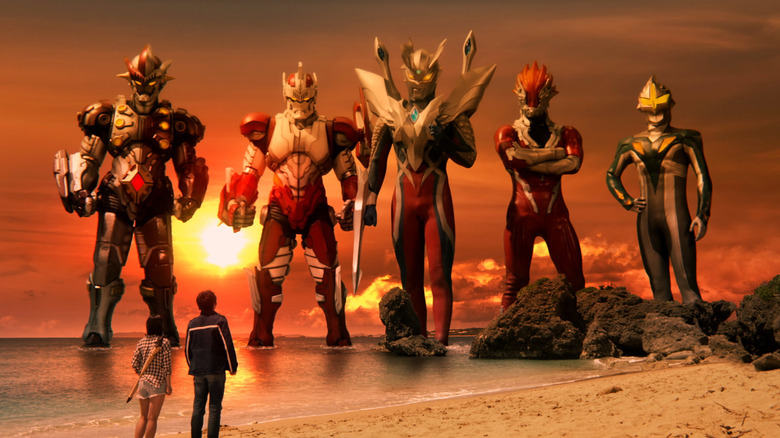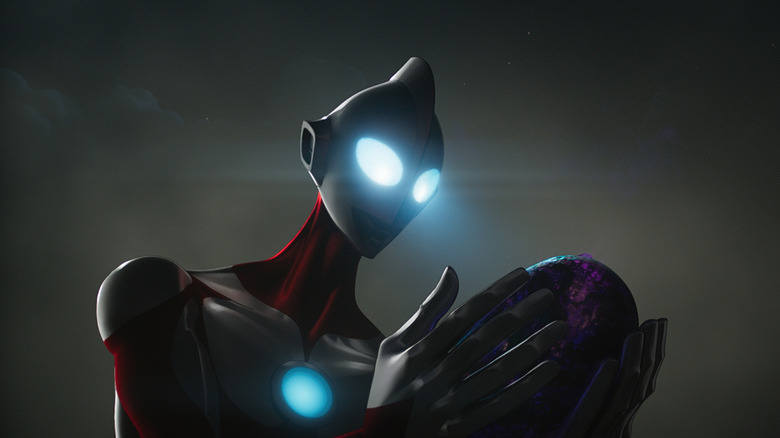Who Is Ultraman, What Are His Powers, & What's With That Costume?
With the new animated movie "Ultraman: Uprising" popping off on Netflix, a whole new audience is getting introduced to one of Japan's most prolific and longstanding sci-fi franchises. While Ultraman has never achieved the same level of international renown as his kaiju cousin Godzilla, the two have similar origin stories, and they've both been incredibly influential in the genre they share. Since "Ultraman: Rising" has been so well-received, it's likely that a lot of new fans are looking into the gargantuan superhero for the first time.
The "Ultra" franchise started way back in 1966 with the Japanese TV series "Ultra Q,' which was immediately followed up by the first "Ultraman" series — a continuation of the same kaiju-centric structure from the first show. Both were created by legendary Japanese filmmaker and practical effects savant Eiji Tsuburaya. More than a decade prior, Tsuburaya had launched himself to success as the special effects coordinator for a little-known 1954 film called "Godzilla."
Alongside director Ishirō Honda, Tsuburaya is credited with effectively creating the kaiju genre. His revolutionary practical effects work, primarily using miniatures and the creature-suit approach later referred to as "suitmation," also earned Tsuburaya the title "Father of Tokusatsu," the genre name for Japanese films centered around practical effects.
"Ultraman" came later in Tsuburaya's career, but it once again revolutionized the genre he helped create. Using repurposed miniatures and creature suits from his time with the "Godzilla" movies on "Ultra Q," he created a new offshoot of the kaiju genre that's remained popular to this day.
Tokusatsu, Kyodai Heroes, and the enduring legacy of Ultraman
The "Ultra" series and Ultraman in particular kicked off a subgenre of Tokusatsu that's often called the Kyodai Hero genre. It focuses on giant superheroes (or occasionally robots, like in the case of Godzilla's co-star Jet Jaguar) who battle various enemies, often kaiju. Often, the hero in question is normal-sized in their day-to-day life but is able to grow to massive heights through either their powers or their suit.
Even if you're new to the Ultraman universe, you likely have some indirect experience with the Kyodai Hero genre. The most prominent example in the West is the "Power Rangers" series, the action scenes of which were ripped straight out of a Japanese Kyodai series called "Super Sentai." The American high school storylines in the various "Rangers" shows were filmed separately to change the context of the fights. Another example appears in "Dragon Ball Z" when Gohan takes on the superhero alter-ego Great Saiyaman. While this character doesn't become enormous, his helmet is very reminiscent of the robot-esque costume stylings of characters from "Ultraman" and "Super Sentai."
In the years since the original series, Ultraman has appeared in dozens upon dozens of movies, live-action shows, animated projects, comics, books, and other media. The franchise is also massive on the toys and collectibles end, having generated billions of dollars in merchandise sales over the years.
What are Ultraman's powers?
In most traditional iterations of the story, Ultraman is the result of two different characters becoming one through alien technology — a human scientist named Shin Hayata, and Ultraman himself, a giant alien warrior from outer space. When transformed into his Ultraman persona, the character mostly relies on size, strength, and melee combat skills to get the job done. However, he also has some more unique tricks up his sleeve.
Ultraman's most iconic attack is called the Ultra Beam, an energy ray he generates by forming his arms into a cross shape. According to the lore, the beam burns at 500,000 degrees and carries 500,000 horsepower. Another energy attack, the Ultra Slash, fires blazing sawblades from Ultraman's hands that can dismember monsters or even cut them in half.
In addition to these combat skills, Ultraman is incredibly durable and possesses impressive stamina. Overall, he's a fearsome fighter, and he's even been shown to be skilled in combat with various weapons, including nunchucks.
How Ultraman: Rising fits into the franchise
"Ultraman: Rising" is a pretty major departure from the franchise norm in several ways. It's animated, for one thing, which isn't typical, and more importantly, it's a co-production between Japanese and Western creatives. The film is directed by American animator Shannon Tindle, whose previous work includes cartoons like "Static Shock" and movies like "Kubo and the Two Strings." "Rising" also changes the core origin story of Ultraman, replacing the typical Shin Hayata character with a baseball player named Kenji Sato.
These changes have a clear goal: introducing "Ultraman" to new audiences who may not have had any experience with the franchise before. So far, it seems that the movie is doing a good job, as it currently holds an impressive 80% critical score and 94% audience score on Rotten Tomatoes. It's also worth noting that this isn't Netflix's first foray into the franchise. An anime adaptation also aired on the platform starting in 2019.
If you're just now getting into the series after watching "Ultraman: Rising," a good next step might be checking out some of the original series and films from the '60s and '70s. You could also check out the big-budget 2022 reboot film "Shin Ultraman," which was directed by "Shin Godzilla" creator Shinji Higuchi.



